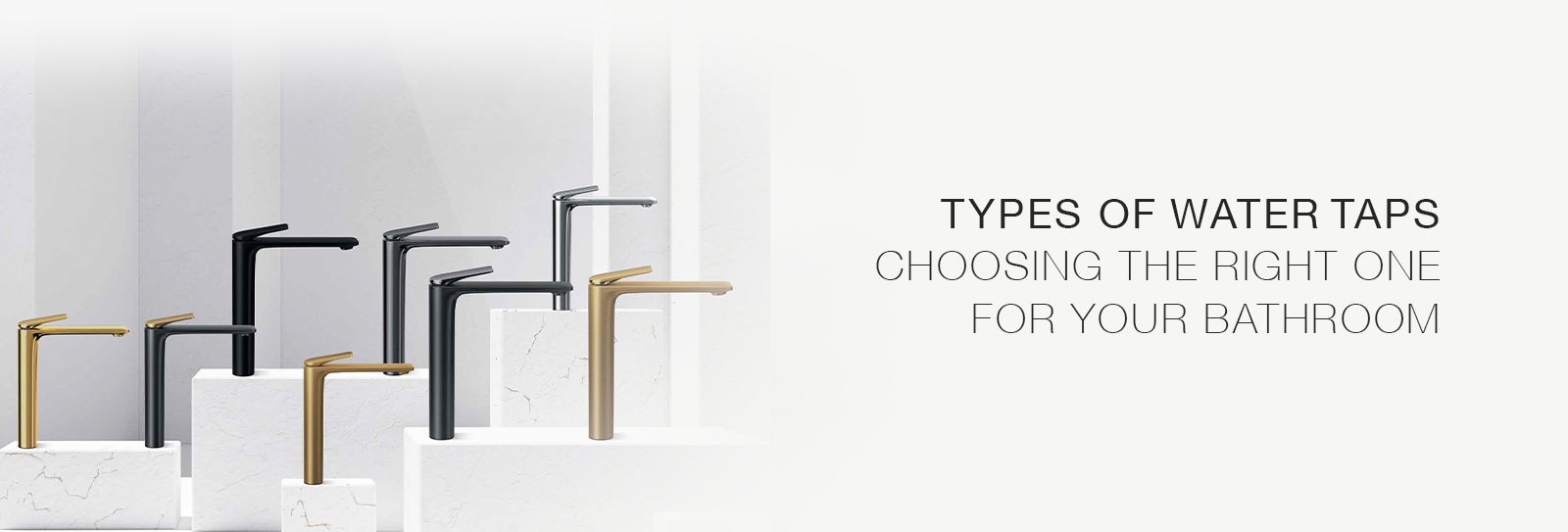Bathroom renovations can be really tough. Especially when it comes down to the details of choosing the right fittings like the suitable types of water taps and sanitaryware. The entire process involves finding what’s available in the market, whether it works for your home from a functional and aesthetic standpoint and whether it meets your budget.
Faucets have been around ever since running water was first available and we’ve come a long way since those days! Nowadays, the sheer variety and types of water taps available in the market are overwhelming and it’s hard to differentiate one from the other, especially for a layman. In this article, we will discuss the different basin tap types so you can make an informed decision for your home.
Different Types of Water Taps
Here is a list of the 5 most common types of water taps that are widely available:
1. Single Lever Taps
Single lever taps are a type of water tap that uses one lever to control the temperature of the water. Generally, when turned towards the right side, you will get progressively hotter water while the left gives you cold water. Besides this, the single lever tap also allows you to control the pressure of the water by lifting the lever up, making this faucet design easy to use. You can also leave the lever in your preferred direction if you are comfortable with a particular temperature so you can always have the best temperature available at all times.
Pros: This faucet design is excellent for bathrooms in particular, as they are easy to use and the washbasin tap installation is easy.
Cons: The only cons to this type of water tap is that it can be more expensive than dual lever faucets. Also, the temperature gets affected by flow changes, which disrupts the consistency.
2. Quarter Turn Faucets
Quarter turn taps function by the opening and closing of ceramic discs that allow the tap to flow with full pressure with a simple 90-degree turn. Because of the low friction, they are an excellent option for people with disabilities, weak grip, arthritis and the elderly. This water tap design utilises newer technology and is one of the most advanced types of manual faucets available today.
The ceramic discs in quarter turn taps are generally more robust and will not need replacing as often as washers in traditional taps do. Having said that, this also depends on your water hardness and water quality.29-May-2020
Pros: Because of the use of ceramic discs, these types of water taps are more robust and they may not need to be replaced for a very long time. Their disability-friendly design also makes it an excellent option for a home with elderly folks.
Cons: If your home has hard water, it can corrode the ceramic discs and make them less durable over time.
3. Pillar Cock Taps
One of the older types of water taps used since the dawn of indoor plumbing, pillar cock taps are most commonly found in older homes. These faucets comprise two separate handles for hot and cold water and work with the help of a compression stem with a washer at its end pushing against the valve seat. To restrict the water flow, the compression is tightened, sealing the valve with the help of a rubber seal.
Pros: Pillar taps have a customisable handle that can be changed based on the washbasin design idea in your home. They are also a more affordable option.
Cons: Because of the rubber used to control the valve, these taps are more likely to leak and may require frequent maintenance.
4. Pressmatic Taps
Commonly found in public areas, pressmatic faucets use a simple mechanism of pressing to release water. When the pressure stops, the water immediately stops flowing. These water tap designs are some of the most water-efficient, making them the perfect choice in public spaces and in children’s bathrooms as the mechanism is simple to use and install.
Pros: Fitting your home with pressmatic taps is an excellent way to save water and one of the most sustainable basin tap types in the market.
Cons: These taps don’t allow you to change the temperature as it is prefixed and mixed before the water is released. They can also be a hindrance when you are trying to fill water as it doesn’t allow for a continuous flow of water without pressing the knob.
5. Automatic Faucets
Lastly, the most new-age types of faucets- an automatic one! Most commonly seen in commercial spaces, automatic faucets are an excellent solution as they have minimal repairs and water waste. This type of faucet works by opening the valve when motion is detected by the LED sensor. Once the sensor stops detecting motion, it automatically stops after a few seconds by closing the valve and stopping the flow of water. The process of a sensor tap fitting is also simple, making it a viable option for your home.
Pros: The most obvious pro of these types of water taps is that it is extremely hygienic and wastes the least amount of water. Because it is touchless, the metal also gets stained less.
Cons: The major con of automatic faucets is that they are more expensive than other types of faucets. The battery also needs to be replaced, which is an additional cost. You also can’t choose between hot and cold water as only a premixed temperature is available to you.
Also watch: Faucet in bathroom designs - ARC Series | Jaquar
While durability, function and cost are important factors in choosing the right type of water tap for your home, aesthetics also play an important role. If you are unsure about this, you can opt for a virtual consultation with Jaquar’s team of experts to find out which one is right for your home. You can also browse through our vast collection of faucets from the comfort of your home today and find the nearest dealer next to you!


